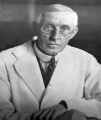Paper - Further note on the pro-chordal plate in man
| Embryology - 27 Apr 2024 |
|---|
| Google Translate - select your language from the list shown below (this will open a new external page) |
|
العربية | català | 中文 | 中國傳統的 | français | Deutsche | עִברִית | हिंदी | bahasa Indonesia | italiano | 日本語 | 한국어 | မြန်မာ | Pilipino | Polskie | português | ਪੰਜਾਬੀ ਦੇ | Română | русский | Español | Swahili | Svensk | ไทย | Türkçe | اردو | ייִדיש | Tiếng Việt These external translations are automated and may not be accurate. (More? About Translations) |
Hill JP. and Florian J. Further note on the pro-chordal plate in man. (1931) J. Anat., 46: 46-47. PMID 17104356
| Historic Disclaimer - information about historic embryology pages |
|---|
| Pages where the terms "Historic" (textbooks, papers, people, recommendations) appear on this site, and sections within pages where this disclaimer appears, indicate that the content and scientific understanding are specific to the time of publication. This means that while some scientific descriptions are still accurate, the terminology and interpretation of the developmental mechanisms reflect the understanding at the time of original publication and those of the preceding periods, these terms, interpretations and recommendations may not reflect our current scientific understanding. (More? Embryology History | Historic Embryology Papers) |
Further note on the Pro-Chordal Plate in Man
By J. P. HILL, D.Sc., F.R.S., and J. FLORIAN, M .D.
(From the Department of Anatomy and Embryology, University College, London.)
IN our preliminary note entitled “The development of head-process and prochordal plate in Man” (this Journal, vol. LXV, part 2, January, 1931), we distinguished in the Dobbin embryo three portions in the axial formation situated in front of Hensen’s knot, Viz. a caudal portion, formed by a typical chorda canal, an intermediate portion in which the chorda process possesses three discontinuous lumina and is accompanied on both sides by lateral mesodermal bands, and a Very short but broad cranial portion formed by a cellular mass, below which no independent layer of endoderm is distinguishable. This cranial portion we interpreted as a prochordal plate which had proliferated t.o form a mass of prochordal mesoderm. The object of this note is to state that we now regard that interpretation as erroneous.
Subsequent to the publication of our preliminary note, we have been able, through the kind permission of Prof. Dr F. Hochstetter, to study and to make photomicrographs of the prochordal plate——head-process region of the embryo Peh,1-Hochstetter (Rossenbeck, 1923) which closely approximates to the Dobbin embryo in its stage of development. In the Peh.1-Hochstetter embryo, the preservation of the cranial portion of the embryonal area is much better than in our embryo, and study of the sections has shown us that its prochordal plate bears no resemblance to our presumed prochordal plate in the Dobbin embryo, but has the form of a small thickened area of endoderm as described by Rossenbeck. In its thickest part the nuclei are arranged in two or three layers, whilst in its cranial part it consists of a single layer of cubical cells. The plate extends through seven sections, and is situated directly in front of what we regard as the anterior extremity of the head-process. In the Dobbin embryo we had observed a comparable area of thickened endoderm, which, however, was much less distinct than in the Peh.1-Hochstetter embryo owing to the poor preservation of this region. The area in question is situated in front of, and extends back a short distance laterally to, our presumed prochordal plate. We had previously attached no special significance to this ‘area, but we are now satisfied that its axial part at least corresponds to the prochordal plate in the Peh.1-Hochstetter embryo, and that the mass which we interpreted in our preliminary note aslformed by the prochordal plate and its mesoderm really represents the most cranial still undifferentiated portion of the head-process.
It is indicated in fig. 1 of our preliminary note as the coarsely dotted area situated close behind the anterior margin of the embryonal area. The area of thickened prochordal endoderm which lies immediately in front of, and laterally to, the dotted area is not indicated in the figure.
With that correction, the rest of the description given in our preliminary note of the preblastoporic axial structures in the Dobbin embryo holds good. These structures we now regard as comprising (1) the prochordal plate, relatively small and indistinct in the Dobbin embryo owing to the state of preservation and not yet in active proliferation; (2) the head-process, distinguishable into three parts, (a) a cranial short but broad segment as yet undifferentiated (the prochordal plate of our preliminary note), (b) an intermediate segment, in which the head-process is distinguishable into a median chorda process containing three isolated lumina of unequal length and two lateral mesodermal bands, (c) a caudal segment, in which the head-process has become transformed into a typical chorda canal provided with seven ventral openings into the yolk-sac cavity and a dorsal opening (blastopore, notopore) situated on Hensen’s knot and leading into the amniotic cavity.
A detailed description of the Dobbin embryo, including a discussion of the development of the head-process and prochordal plate in early human embryos has been completed and will be published elsewhere (A Young Human Embryo (Embryo Dobbin) with Head-Process and Prochordal Plate Phil. Trans. Roy. Soc. B. vol. 221.).
Cite this page: Hill, M.A. (2024, April 27) Embryology Paper - Further note on the pro-chordal plate in man. Retrieved from https://embryology.med.unsw.edu.au/embryology/index.php/Paper_-_Further_note_on_the_pro-chordal_plate_in_man
- © Dr Mark Hill 2024, UNSW Embryology ISBN: 978 0 7334 2609 4 - UNSW CRICOS Provider Code No. 00098G



